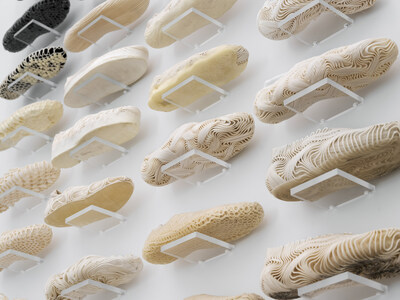OXMAN, a design lab whose mission is to create and provide nature-based products to its clients has revealed O°, a biomaterial, digital, and robotic technology platform that boosts the production of biobased textiles and wearables that are 100% biodegradable when disposed of. Those textiles and wearables are made of organic material without using petrochemicals or glues and do not produce any microplastics.
O° (pronounced “O-Zero“) eliminates the complexity inherent in conventional fabrication steps. This allows the creation of consumer products from one material, under a single roof, with less human intervention and a zero-waste process.
The first product to be built using the O° platform is a collection of shoes made from polyhydroxyalkanoates (PHAs), an organic material famous for its versatility and biodegradability.
The CEO and Founder of OXMAN, Neri Oxman has revealed that “PHAs have long been recognized as a promising alternative to petroleum-based plastics. We have successfully elevated the potential of PHA through the development of O°, a new technology for designing and fabricating products that seek to minimize harm in its conception and nourish the environment in its afterlife. We are thrilled to unveil our first product using this new technology: the O° shoe, made using 100% PHA, is 100% biodegradable, and has no petrochemicals or microplastics.”
0% petrochemicals, 0% forever chemicals, 0% microplastics, and 100% biodegradable
PHAs can be developed using bacteria that consume atmospheric carbon dioxide, methane, and food waste to remove carbon in the environment once they grow. They are biologically recyclable, and 100% biodegradable in comfortable conditions. Ultimately, O° textiles and shoes break down without microplastics during decomposition.
As they’re made of PHAs, they can decompose by blending into the environment and returning to the bacteria from which they originate. However, like traditional biodegradable materials incorporated for apparel such as cotton, wool, and silk, PHA won’t biodegrade when worn, washed, or stored.
The O° robotic system 3D prints customized PHA blending onto a textile, 3D knitted on an industrial flatbed machine from 100% PHA yarn produced via extrusion and melt spinning.
With this knitting and printing technology for creating shape and movement, OXMAN has removed the cut-and-sew and adhesion techniques linked with traditional shoe assembly.
The O° technology offers a near zero-waste production method with minimal human intervention. It allows domestic, low-cost production, reducing the transportation charges and environmental impact of distant supply chains, a common concern in the shoe sector.
Many industrial pigments and dyes are produced from petrochemicals. These elements release environmentally affecting chemicals during their production. These dyes and pigments are based on a resource-focused global supply chain for synthesis, processing, and transportation.
Meanwhile, bacteria can create pigments from abundant natural resources. O° incorporates bacteria as a source of material and encodes other functional features such as pigment production to streamline the manufacturing process.
OXMAN‘s O° platform is based on the potential of PHAs. It tunes the fabrication process and offers an alternative design that holistically considers a product’s lifecycle from conception to decomposition.
Author: Nagarjun M
Remember, you can post free-of-charge job opportunities in the AM Industry on 3D ADEPT Media or look for a job via our job board. Make sure to follow us on our social networks and subscribe to our weekly newsletter: Facebook, Twitter, LinkedIn & Instagram! If you want to be featured in the next issue of our digital magazine or if you hear a story that needs to be heard, make sure to send it to contact@3dadept.com.






